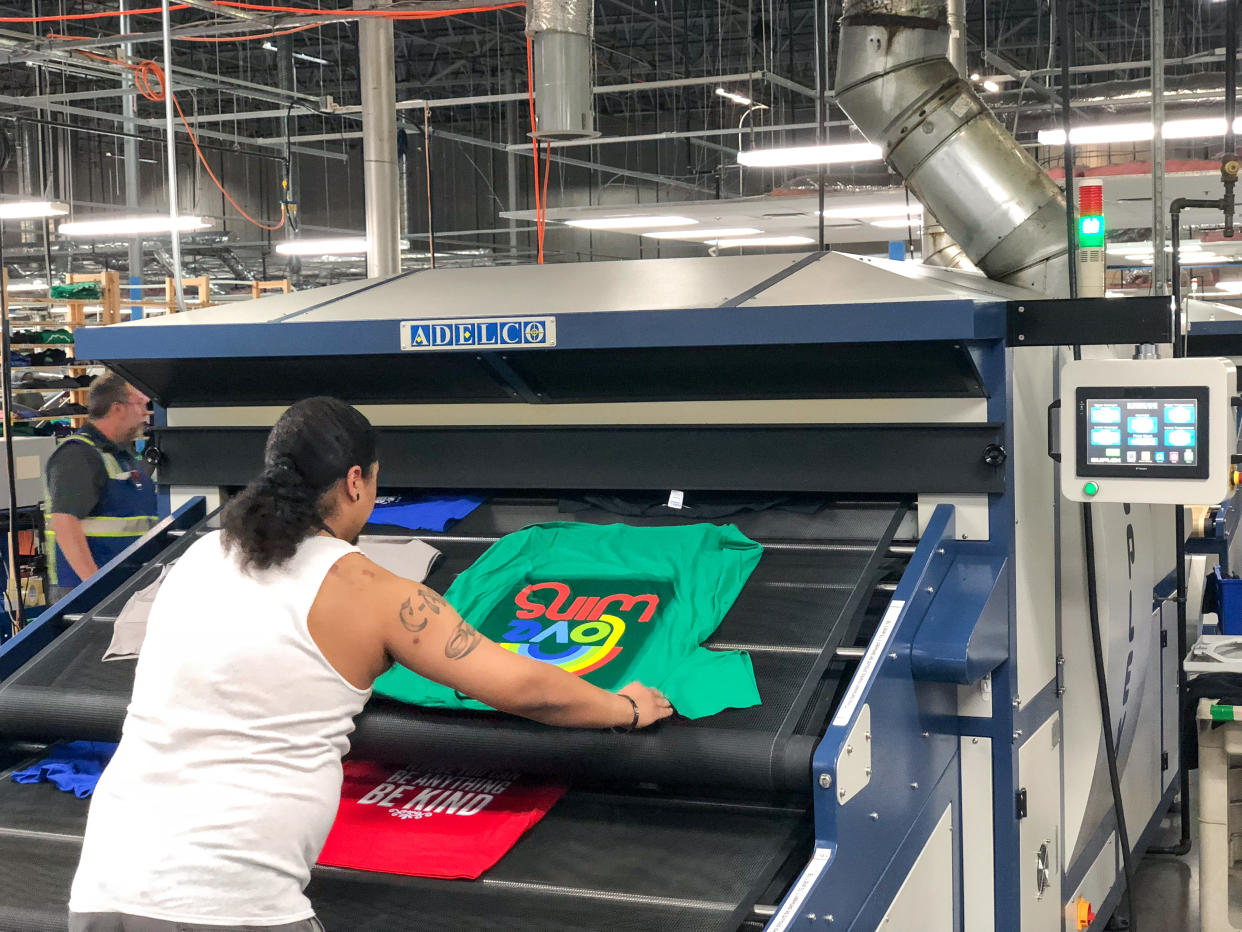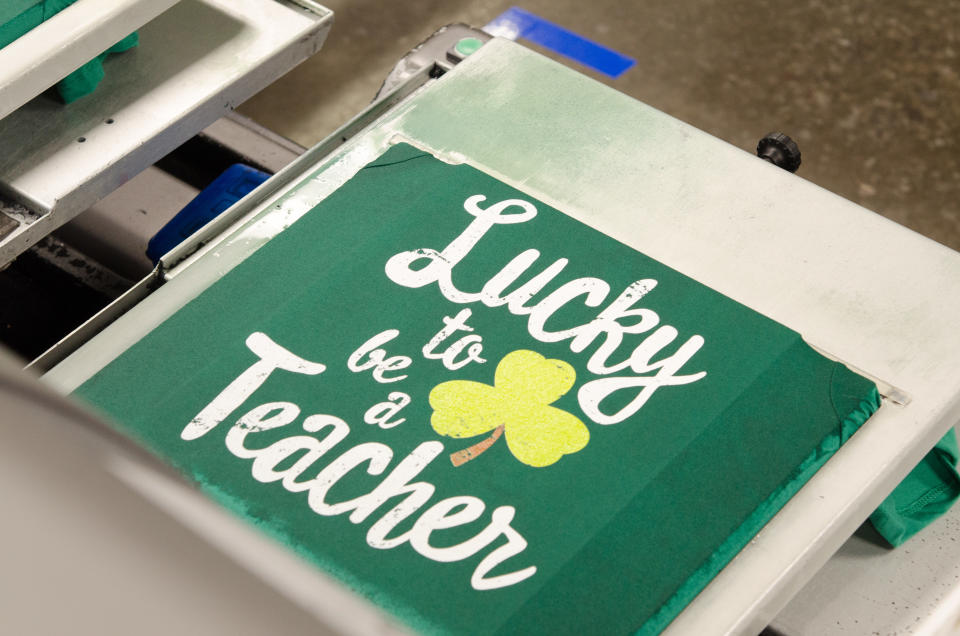Inside Amazon’s little-known graphic T-shirt-making business

When Monette Escaname-Requenez, an engineer in Texas, bought a black T-shirt with an Uncle Sam cartoon character for July 4 on Amazon (AMZN), she had no idea that it was actually made by Amazon. She just thought it was sold and delivered by Amazon. The print quality “looks to be pretty legit,” she said.
The Seattle-based e-commerce behemoth is known for its logistic system and for disrupting the retail industry, but few know that it is also in the printing and manufacturing business. Thousands of T-shirts like the one purchased by Escaname-Requenez are printed on-demand at Amazon facilities in Texas and Pennsylvania and then shipped nationwide. All the designs come from a program called Merch by Amazon, which has attracted big-name studios as well as amateur designers.
From game fans to Main Street

Merch by Amazon was originally for game developers who wanted to expand beyond traditional in-app advertising or purchases to physical products. Developers upload their own T-shirt designs, then Amazon prints it on demand and sells it. For each T-shirt sold, the design creator earns a royalty that increases based on sales and does not have to spend money on manufacturing and fulfillment work.
Soon Merch by Amazon expanded beyond the game fans circle, as holiday-themed designs and political slogans sprung up. Unlike other Amazon private label products, it’s not easy to tell which T-shirt is made by Amazon. Most customers, like Escaname-Requenez, don’t realize a shirt is printed inside Amazon factories.
Miguel Roque, director at Merch by Amazon, said he’s cautious about putting a Merch by Amazon logo on the product page. “It’s all about the customer and making good customer decisions,” he told Yahoo Finance. “Customers are buying a design they love. I don’t know when they’re making that buying decision, if they necessarily care or it’s gonna influence their buying decision.”
The minute a customer orders a T-shirt from the Merch program, Amazon sends that order to fulfillment centers closest to the destination of the customer. The printing process is similar to printing on paper. When an order comes in, racks of shirts are rolled over into the printers. At the end of the process, a finished T-shirt gets dried and folded before it is shipped to the customer.
Amazon said it prints, ships and gets an order to a customer within two days. Escaname-Requenez received her T-shirt four days after placing her order.
Manufacturing the Amazon way

Amazon has been on a hiring spree for its warehouses across the country, and employees are essentially working alongside robots. The same approach has been applied to its manufacturing process — to make a T-shirt, Amazon adopted digital printing by using highly-automated machines by Israel-based Kornit Digital.
The first facility in Dallas was a former site for Woot!, an Amazon subsidiary. There were a few printers, but more were imported as the program expanded. Amazon’s 110,000-square-foot plant in Norristown, Pennsylvania, opened after it got the environmental approval last November. In January 2017, Amazon received an option to invest up to $38 million in Kornit Digital, taking an 8% stake in Kornit.
While analog remains to be the most common printing process, Amazon has fully adopted digital printing in pursuit of better quality and higher efficiency. In 2017, digital printing only accounted for 16.2% of the global print market value and 2.9% of the volume, according to Smithers Pira, the specialist market research provider.
The labor needed in the digital printing process is much less than what’s needed in the traditional analog approach, according to Brian Drab, an analyst covering industrial technology at William Blair, a Chicago-based investment advisor.
“In that analog printing of textile, there is a lot of labor to set up the machine,” Drab told Yahoo Finance. “In digital printing, all of that setup we’ve talked about doesn’t exist. There is very little labor with digital compared with the labor in analog.”
Amazon declined to share headcount for the two printing facilities but Roque said there are a lot of people working in the facilities as printing still requires manual labor.
Crowdsourcing designs

To participate in Merch by Amazon, designers have to apply for the program. The program’s tier system, based on a designer’s selling history and sales volume, determines how many designs a person can upload. The higher tier, the more designs you can upload.
In December 2015, Ken Reil, a graphic designer in Las Vegas, received a few dollars from Amazon after trying out Merch by Amazon. Today, Reil has 8,000 designs live on Amazon and 50-150 of his shirts are sold each day, which brings him a monthly income of $10,000 to $15,000. Even his 14-year-old son signed up and has earned $2,000 from the T-shirt business, according to Reil.
“Merch by Amazon is not just about artsy graphics. Some intense artistic designs aren’t the ones that sell the best,” Reil told Yahoo Finance. “A lot of time it’s the text style T-shirt, since everyone wants to wear their phrase on their chest now.” He sees more demand for this given the political climate.
Reil used to work with other print-on-demand companies like TeeSpring, but has shifted his focus to Merch by Amazon because of market accessibility. “No one can match the size [of] the Amazon marketplace. There is a lot of organic traffic. Amazon has people already there searching for products,” said Reil.
Expanding into more products

Merch by Amazon can currently print an accepted design on two types of T-shirts in 15 sizes and 21 colors, as well as long sleeve shirts, sweatshirts and hoodies. It has been testing new products like popsockets that stick on the back of cellphones and act as grips and stands.
A regular popsocket from the Merch program is priced at $14.99 on Amazon. Reil said popsockets are already popular among customers choosing his designs.
Amazon is also experimenting with phone cases and looking to offer more products. “I can tell you anything that you can print on demand, we’re considering it,” said Roque, adding that Amazon is always taking customer feedback. “The key thing is that we are able to produce it at scale, and with a degree of quality that we think both brands and customers will be really satisfied with.”
He acknowledges opening new factories won’t be easy, even for Amazon. “In order to create one of those facilities, it takes quite a bit of planning and capital investments, so it’s a long-range project,” said Roque.
Krystal Hu covers technology and economy for Yahoo Finance. Follow her on Twitter.
Read more:
Amazon to offer Whole Foods discounts to Prime members nationwide


